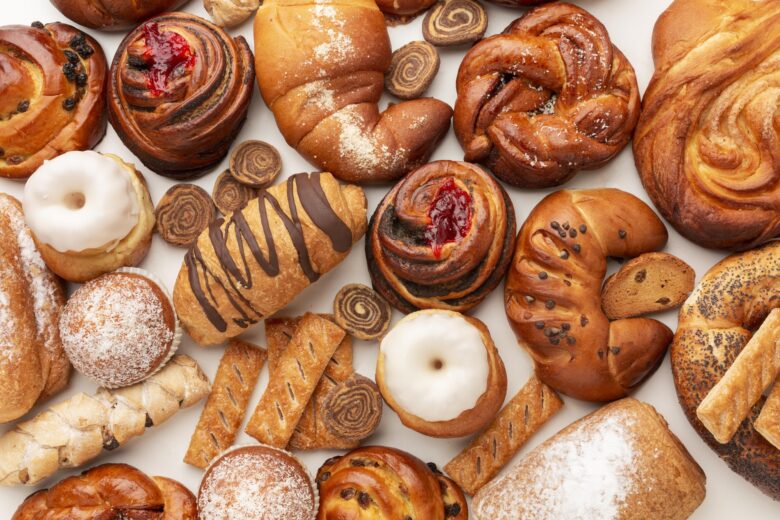Choosing the right flour can make or break your baking results. Each type of flour brings its own structure, texture, and flavor to baked goods. Whether you’re baking fluffy cakes or crusty bread, knowing the differences between flour types—and when to use them—can elevate your baking game. This guide will help you confidently choose the best flour for any recipe.
Why Does the Type of Flour Matter in Baking?
Flour is more than just a base ingredient; it’s a structural building block in baking. The choice of flour affects everything from a bread’s chew to a cake’s crumb. Different flours contain varying levels of protein, which determines how much gluten will form when mixed with liquid. Gluten provides elasticity and strength, making it essential for items like bread and pizza dough, while lower protein levels ensure tenderness in cakes and pastries.
For example, using bread flour in a cake recipe can result in a dense, chewy texture—far from the light and airy result you were likely aiming for. That’s why understanding protein content is key to baking success.
How Does Protein Content Affect Your Bakes?
The amount of protein in flour directly influences the formation of gluten. High-protein flours develop strong gluten networks, ideal for bread and other yeasted products that need to rise and hold shape. Lower-protein flours create weaker gluten structures, which are perfect for delicate, tender baked goods like cakes and pastries.
According to King Arthur Baking (2023), bread flour typically contains 12–14% protein, while cake flour has around 6–8%. This wide range significantly influences the final texture of your baked item.
Comparing Common Types of Flour
| Flour Type | Protein Content | Best Uses |
|---|---|---|
| Bread Flour | 12–14% | Yeast breads, bagels, pizza crusts |
| All-Purpose Flour | 10–12% | Cookies, muffins, quick breads, pie crusts |
| Pastry Flour | 8–9% | Pie crusts, biscuits, scones |
| Cake Flour | 6–8% | Cakes, cupcakes, delicate pastries |
| Whole Wheat Flour | 13–14% | Hearty breads, muffins, pancakes |
| Self-Rising Flour | 8–9% (with leavening agents) | Biscuits, pancakes, quick breads |
| 00 Flour | 11–12% | Pizza dough, pasta |
Sources: King Arthur Baking, Real Simple
In-Depth Guide to Each Flour Type
Bread Flour
Bread flour has the highest protein content, ranging from 12–14%. This high level of protein creates a strong gluten network, resulting in chewy, well-structured breads with a crisp crust. It’s ideal for yeast-leavened recipes like artisan loaves, bagels, and pizza crusts that require a good rise and strong internal structure.
All-Purpose Flour
With 10–12% protein, all-purpose flour is the go-to choice for everyday baking. It offers a balanced texture suitable for cookies, muffins, quick breads, and even pie crusts. Its versatility makes it a pantry staple, especially for home bakers who want one flour that does it all.
Pastry Flour
Pastry flour contains around 8–9% protein, resulting in a tender and flaky texture. It’s commonly used for pie crusts, biscuits, and scones where minimal gluten development is desired. For a DIY version, you can mix cake flour and all-purpose flour to approximate pastry flour.
Cake Flour
Cake flour has the lowest protein content of all wheat flours, between 6–8%. It produces a soft, fine crumb, making it ideal for light and airy cakes, cupcakes, and delicate pastries. To prevent clumping, it’s often sifted before use due to its fine texture.
Whole Wheat Flour
Made from the entire wheat kernel, whole wheat flour is high in protein (13–14%) but also contains more fiber and oil. These additions result in denser, more flavorful baked goods. It’s often combined with all-purpose flour to lighten the texture while maintaining nutritional value.
Self-Rising Flour
Self-rising flour is all-purpose flour that includes baking powder and salt. With a protein content of 8–9%, it’s commonly used for biscuits, pancakes, and quick breads. However, it’s not suitable for yeasted recipes and can’t be used as a direct substitute unless leavening is accounted for.
00 Flour
This Italian flour is finely milled and contains 11–12% protein, making it smooth and elastic. It’s prized for its ability to create silky pasta dough and thin-crust Neapolitan-style pizza. The fine texture leads to a soft bite and crisp exterior in pizza crusts.
Smart Substitutions: What to Use When You’re Out of a Specific Flour
Running low on a particular type of flour? Understanding protein content helps you find the closest match. For instance, if you’re out of cake flour, you can create a substitute by combining one cup of all-purpose flour minus two tablespoons, plus two tablespoons of cornstarch.
When replacing whole wheat flour, consider blending white flour with added bran for a similar taste and fiber content. Substitutions should always take texture, rise, and flavor into account.
Which Flour Should You Use for Your Favorite Bakes?
Here’s a quick reference to help guide your flour choices:
- Cakes and cupcakes: Cake flour
- Cookies and muffins: All-purpose flour
- Bread and bagels: Bread or whole wheat flour
- Pizza and pasta: 00 flour or bread flour
- Biscuits and pancakes: Self-rising or pastry flour
Choosing the right flour helps you control the final texture, ensuring better results every time.
Final Thoughts: Matching the Right Flour to the Right Bake
The type of flour you choose has a powerful effect on your baked goods. From structure to flavor, each flour brings unique properties to the table. Understanding protein content and texture outcomes allows you to bake with confidence and precision.
Start your next recipe with the right foundation—choose the flour that fits your flavor and texture goals!



